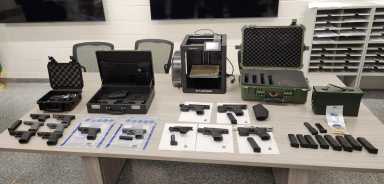Rosedale Man Charged After NYPD Finds 3D-Printed Ghost Gun Trove in Queens Home

As the shadowy trade in “ghost guns” surges across New York City, a Queens man’s 3D-printed arsenal crystallises the mounting challenge these untraceable weapons pose to urban safety and law enforcement.
A noisy intersection in Rosedale—typically the preserve of commuters and Sunday shoppers—recently played host to a different spectacle. On October 5th, the NYPD and the Queens District Attorney’s Office swooped down on a modest home on Edgewood Street, emerging with a trove more commonly associated with dark-web crime dramas than suburban New York life: eight firearms (seven of them so-called “ghost guns”), over a hundred rounds of ammunition, twelve magazines, and a desktop 3D printer humming in the corner. The man at the centre of this arsenal, 22-year-old Lianu Luis Brown Delgado, now faces a daunting 51-count criminal complaint.
Ghost guns—firearms assembled from parts with no serial number, often produced using commercially available 3D printers—have become New York City’s fastest-growing public safety headache. Queens District Attorney Melinda Katz, not generally known for melodrama, called the seizure “significant,” describing the stockpile as putting “countless lives in danger.” The charges against Mr Delgado include multiple counts of weapons possession and unlawful ammunition storage; if convicted, he could spend up to 15 years behind bars.
New York’s gun laws, among the strictest in the United States, have long relied on paperwork, permits, and serial numbers to track firearms from shop counter to city street. Ghost guns slip past these controls with unsettling ease. Since 2021, Queens alone has led the city in ghost gun recoveries, with 303 such weapons seized from the borough—chalking up a dubious distinction for a fourth straight year, and comfortably pacing ahead of Manhattan, Brooklyn, and the Bronx for 2025 already.
For city dwellers, the emergence of DIY weaponry carries more than just an academic interest in criminal law. Unregistered, untraceable, and easily modified, ghost guns enable criminals, minors, and buyers denied traditional gun purchases—for reasons of age, record, or mental health—to circumvent the state’s presumed prophylaxis against mayhem. The vast majority of these weapons, according to recent NYPD briefings, turn up not in organised-crime busts, but in street disputes, domestic incidents, and opportunistic armed robberies. The risk, in short, is as diffuse as it is unpredictable.
The economics of production exacerbate the menace. Where a secondhand handgun may change hands for $400-500, a 3D printer and a set of blueprints cost little more on eBay or the darknet, yielding potentially dozens of weapons over their working life. Law enforcement must track not just the product but the tools of manufacture—the “printing presses” of the digital arms revolution.
Adding to the complexity, legislation lags technological innovation. Congress’s 1988 Undetectable Firearms Act predated the rise of consumer 3D printing; its patchwork of federal and state rules now creaks under the strain of digital files that cross borders as easily as email. The Bureau of Alcohol, Tobacco, Firearms and Explosives (ATF) and New York’s own state police have increasingly lobbied for tighter curbs on parts kits and online blueprints, but such efforts often founder on the First and Second Amendments, those twin pillars of American constitutional wrangling.
The broader social implications play out not just in courtrooms, but in school corridors, hospital trauma bays, and the uneasy calculation of the city’s budget. Recent research from the Johns Hopkins Center for Gun Violence Solutions found that jurisdictions facing surges in ghost gun recoveries also experience bumps in both homicide and non-fatal shooting rates, a pattern New York’s policymakers nervously recognize in annual crime statistics. The cost to taxpayers mounts not simply in policing, but in prosecution, healthcare, and lost productivity.
A test for New York’s legal and political resolve
Such woes are hardly unique to the five boroughs. Nationally, the ATF last year reported recovering over 20,000 ghost guns—up almost tenfold since 2017—with hotspots stretching from Philadelphia to Los Angeles. But New York’s gun-control regime, traditionally vaunted as a model for urban America, now looks vulnerable to technological evasions from tinkerers and profiteers alike. In comparison, European cities, which largely ban both civilian gun ownership and the private fabrication of firearms, have seen far fewer home-printed weapons despite similar levels of technical sophistication.
The political reaction, as is its nature, has been swift and at times shrill. Local legislators in Albany and City Hall have scrambled to tighten laws on gun parts and enforcement—the so-called “gun kit ban” being one recent example—but criminal ingenuity often leaves lawmakers a step behind. Federal action, which would harmonise enforcement, remains, by Washington standards, a distant prospect.
It would be a mistake to view the Rosedale cache as either an isolated oddity or the harbinger of imminent urban collapse. Even within Queens, the share of ghost guns in overall weapons recovered by police, though rising, remains modest—a fraction compared to trafficked conventional firearms from less-regulated states. Still, the trendline bodes poorly for complacency. As production grows easier and files spread virally, the very assumptions underpinning city gun law—traceability, licensure, deterrence—grow tatter-edged.
A classically liberal city, wary of both heavy-handed policing and rampant disorder, faces an awkward choice: double down on regulatory ingenuity, or risk ceding the upper hand to the home workshop. The incremental, data-driven approach rankles those hoping for simple solutions, but remains the city’s best prospect. Advocates for both safety and liberty would do well to recall that innovation’s promise, in this case, cuts both ways.
The saga of Mr Delgado and his suburban 3D arsenal will not be the last of its kind in the city’s criminal annals. But it serves as a brisk reminder: in an era when manufacturing can migrate from factory to flat, the burden of vigilance must do so as well. ■
Based on reporting from QNS; additional analysis and context by Borough Brief.